Claussen Pickles are kosher dill pickles at their crunchiest, saltiest best! These homemade Claussen pickles taste like the commercial ones you find at the store, but better. And better yet, they’re ridiculously easy to make!
Whether you’re new to pickle making or a pickle veteran, you NEED to make these half sour pickles! And wonder of wonders, you don’t need to know how to can to make these super fresh, crunchy pickles! Claussen dill pickles are meant to be eaten fresh.
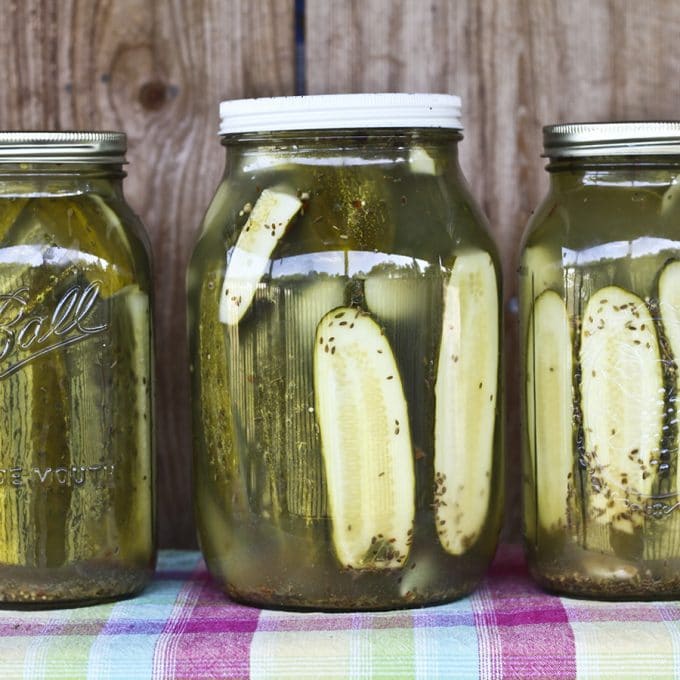
Homemade Claussen Knock-Off Pickles: Always crunchy and garlicky, this perfect homemade pickle recipe requires no special equipment, & no canning experience.
It’s common knowledge that I have a salty tooth rather than a sweet tooth. When the weather does what it has been doing lately (making us all do our best Shadrach, Meshach and Abednego impersonations) I can’t think of a single thing I find more refreshing than an icy-cold, salty, crunchy pickle.
It’s not just me, it’s my whole family: mother, sisters, brothers, cousins, aunts, grandparents, kids, husband… I married a man who loves pickles so much he eats the pickles and then drinks the juice from the jar.
I grew up eating my Grandma’s homemade dill pickles like the supply was endless and moved on to canning my own pickles as soon as I had a kitchen of my own. There’s just something about a homemade dill pickle that makes me happier than any pickled cucumber ever should.
My little sister, Jessamine, and I compare our homemade pickles from year to year the way some people compare wine vintages.
Dill Pickle Recipe
But there is one pickle that stands head-and-shoulders (were pickles to *have* heads and shoulders) above all others. I’m talking about the pickles you see here. That’s right: Homemade Claussen Dill Pickles.
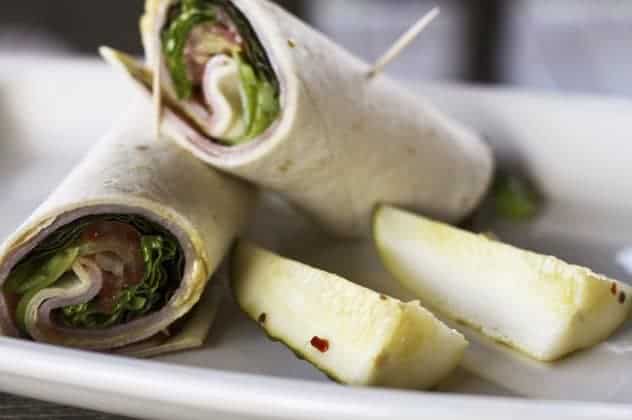
Recipe for Claussen Pickles
What do you need in order to make this recipe for Claussen Half Sour Pickles at home? Let’s get a quick list for both ingredients and equipment out of the way, shall we?
Equipment for Making Claussen Pickles at Home
- A Glass gallon jar or 4 glass quart jars or other food safe container with a tight fitting lid
- Measuring cup
- Chef’s knife or paring knife
Ingredients for Making Homemade Claussen Pickles Copycat
- Small to medium size pickling cucumbers (check your local farm stand or farmer’s market!)
- Apple Cider Vinegar (don’t fret- it doesn’t taste like apple cider and isn’t even a little sweet!) or white vinegar
- Kosher Salt
- Garlic
- Dill (either fresh or dill seed)
- Pickling spices (available here)
A quite note on your vinegar choice: I opt for apple cider vinegar because it’s a smoother vinegar than white vinegar. It does not impart any sweetness or apple taste to the pickles whatsoever.
If you can’t find it (pssst. It’s right next to white vinegar in even moderately stocked grocery stores) or don’t feel like buying it, you can most certainly substitute white vinegar. It’ll just taste a little sharper. (And technically store bought Claussen pickles have white vinegar, so you do you!)
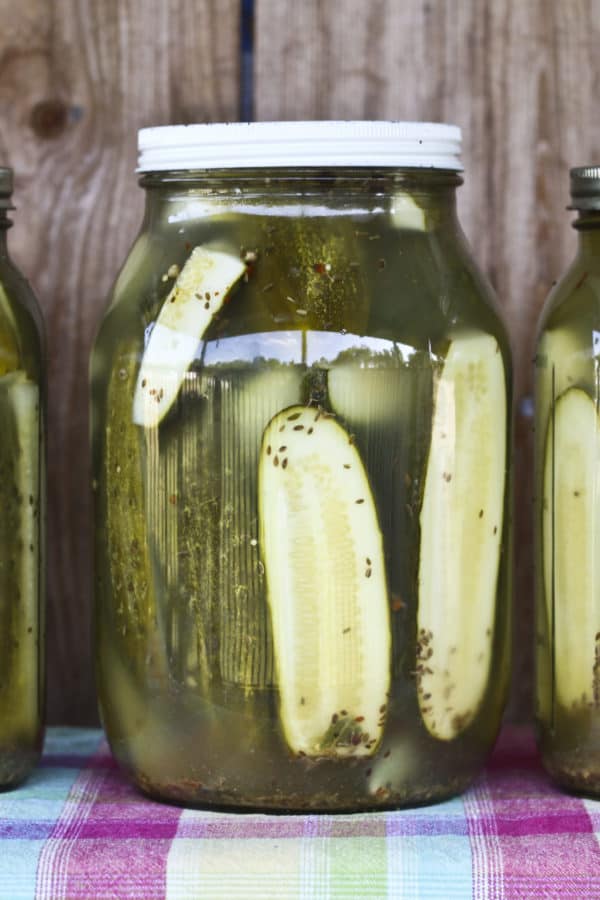
And ya’ll. These homemade half sour pickles are so easy to make it’s almost criminal.
The hardest part is the 2 to 4 day wait for them to be done. Truth be told, though, I’ve snacked on them the day after I made them and been a very happy camper.
Claussen Pickle Recipe
These are homemade refrigerated deli pickles, also known as Lithuanian half-sours, also known (in the commercial equivalent) as Claussen dill kosher pickles, also known as the best pickles ever known to mankind.
Here’s the thing. While I do love my other homemade pickles dearly (otherwise why would I continue canning ninety-something quarts year after year after year), these are by far my all-time favourites.
CRUNCH. That’s what you hear when you bite these. There is no flop, no squish, no soft pickles. These things almost bite back.
This also happens to be the perfect dill pickle recipe for beginning pickle makers. If you’re not into canning, these refrigerator pickles are a godsend. Even if you ARE canning obsessed, like yours truly, this Claussen pickle recipe should be in your pickle repertoire too.
Please note that this Claussen pickle recipe is not suitable for canning. The brine is fermented and not very acidic, which means it has far too high a PH to can safely. If you’re looking for a great canned dill pickle recipe, try this home canned garlic dill pickle recipe.
Refrigerator Pickles
Here’s where we get into the best part of this pickle recipe (aside from the crunch and flavor). You don’t have to cook anything to make these pickles; not one single thing. The brine is stirred together, the cucumbers are rinsed, trimmed and stuffed into a jar with garlic cloves and spices.
These half sour pickles are NOT CANNED. They are simply put into jars. Amen!
When it’s summer time and the idea of turning on the stove makes me want to crawl into an (air conditioned) hole, these pickles are a welcome treat. Not only is that cold crunchy refrigerator pickle waiting to cool me off at the end of the prep time, but I don’t have to heat up my kitchen by even one single degree to get there.
Remember that pickling isn’t just for cucumbers, either! Try out our Pickled Brussels Sprouts, Quick Pickled Red Onions, and famous Candied Jalapenos!
How to Make Pickles FAQ
Please, please, please give these a go even if you have never made a pickle before. There is nothing scary or intimidating here. Wash, slice, stuff, stir, pour, sit, wait.
- Trim 1/8-inch from the blossom end of each cucumber and slice them in half lengthwise or into quarters. The size you choose depends on how large your cucumbers are and how big you want the pickles to be when they’re done. This helps minimize the chances of soft pickles.
- In a gallon jar (or large, wide-mouth, food-safe container) layer the dill heads or seed, pickling spice or mustard seed, and garlic cloves and sliced cucumbers. If you’re dividing the cucumbers up between smaller containers, just divide the garlic and spices evenly between the containers, too.
- Stir your brine together in a separate container. You WILL have more brine than you have space for in the jars, but that’s why you pack the spices in the jars. Just store extra brine in a jar in the refrigerator and use it to top off your pickles if the brine starts evaporating.
- Pour the brine over the cucumbers, taking care to make sure all of them are fully submerged. If needed, place a plate or mug or other ziploc bagged can of beans on the cucumbers to weigh them down and keep them under the brine!
- Cover the jars lightly not tightly and leave out of direct sunlight on the counter for two to four days or until the pickles are picklicious.
- If your kitchen is pretty hot or humid, you can stash them directly in the refrigerator. They’ll just take a couple of days longer to get fabulous. Your patience will be rewarded.
On the plus side, the wait is only two to four days which is significantly less than the six week wait of the canned pickles. Besides, as I said, there is the crunch factor
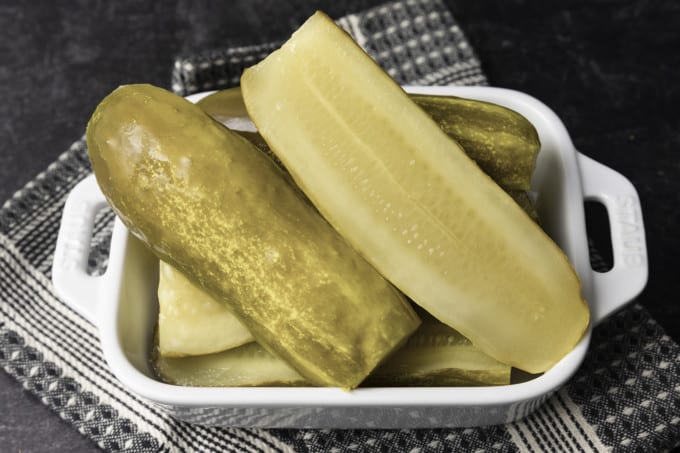
Troubleshooting Your Homemade Claussen Pickles
These pickles are easy peasy to make, but there still may be a couple of things that pop up from time to time that make you go “Hmmm…” In no particular order, here are some of the most commonly asked questions about them and some answers!
- Why is my pickle brine cloudy? Okay, I lied. This is the most common question and that’s because the brine becomes cloudy naturally as a consequence of fermentation (which is what’s happening here.) No worries.
It’s all natural. This half sour pickle recipe (more on this to come) is a fermented pickle recipe and that just happens.
Another possible cause of intense cloudiness or discolouration in your brine is using table salt. The iodine in table salt can also give off flavours to your pickles, so it’s best to stick with kosher salt or pickling salt for these bad boys! - Is the scum, foam, or film on top of my pickle brine dangerous? It’s that pesky (and delicious) fermentation again! This is another thing you don’t have to worry about.
Just scrape it off with a spoon, discard, and top off with a little of that extra brine you whipped up. (See the recipe card for details.) But do remove the scum or it could cause your pickles to go bad. - My pickles went soft! How do I prevent this? This particular tragedy could have two causes.
First, you may have failed to remove enough of the blossom end of the cucumber. There is a naturally occurring enzyme in the blossom end of cucumbers that causes pickles to break down and become soft if it is not removed. Next time, just slice more off.
Second, you may have started with less than spectacularly fresh cucumbers. An older cucumber has had longer for the aforementioned enzyme to kick in, and it has already started its work.
The best solution for this issue is to use cucumbers that have either been picked fresh that day or have been refrigerated steadily since very shortly after being picked a couple of days previously. - Why did my pickles go bad? See that second reason in the “why did my pickles go soft” bullet point? That’s one culprit.
Other potential causes of spoiled pickles are using unwashed cucumbers or fresh dill, old or decayed garlic, bad spices, lower-than-5%-acidity-vinegar, failing to remove the scum from the brine or to keep the pickles submerged in the brine, or storing your pickles in warmer conditions. When in doubt, stash them in the refrigerator! - Why is there mold on my pickles? First, you have my condolences. Second, it’s because your pickles didn’t stay submerged in the brine. That brine has enough salt and acid to prevent mold growth if the cucumbers stay under the surface.
If you’re having trouble finding something that fits in the jar to keep this from happening, try popping a can or two of tomato paste or canned beans in a zipper top bag and gently inserting that into the jar. It should weigh it down enough to do the job. - Should I worry about the white sediment in my jar? This is another one in the “don’t sweat it” category. There are two potential reasons and both are completely harmless.
It’s either a natural consequence of the fermentation or anti-caking agents in the salt. Neither harms the pickles or effects the flavour, so don’t worry! - Why is my garlic blue/green/purple? As long you inspect the garlic before it goes into your jars and it is fresh as a daisy, you have nothing to worry about. It could be the type of salt you used or it could be the variety of garlic. Some types of garlic have a natural propensity to change pretty colours in vinegar.
It also may mean that your pickles were exposed to light. When garlic is exposed to light, it starts producing chlorophyll which is green. It also may indicate that your garlic is more mature.
In that case it is caused by sulfur compounds that naturally occur in more mature garlic reacting with minute traces of copper in the vinegar., but as long as there are no other signs of spoilage (soft or squishy texture, funky smell, discoloured spots), you’re good to go.
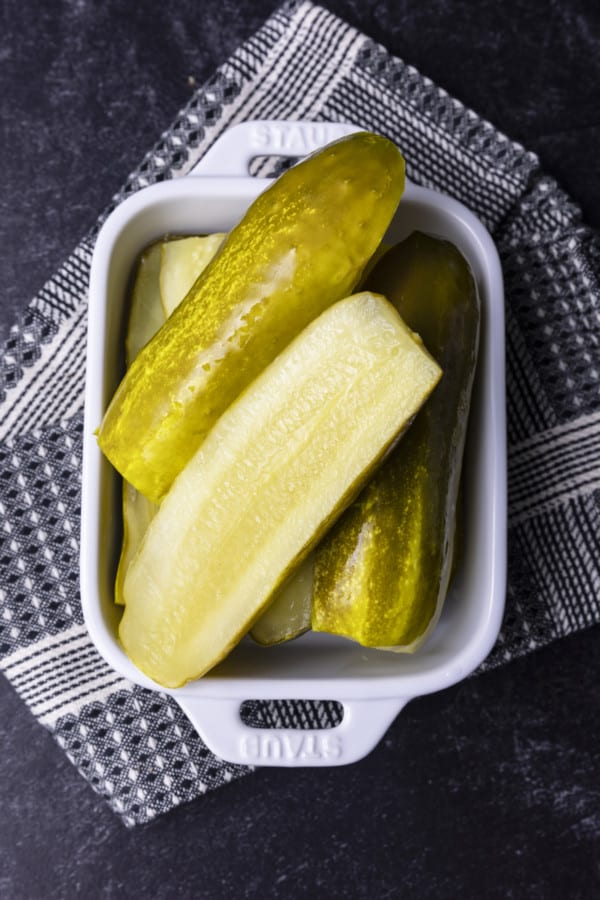
IMPORTANT NOTE: Because there is so much diversity in temperature, humidity, age of cucumbers, etc… involved in this recipe, please check your half sour pickles starting at 24 hours for doneness. If the pickles smell/taste pickley, move them to the refrigerator. Do not keep them on the counter longer than 4 days.
ANOTHER IMPORTANT NOTE: These pickles are not suitable for canning. They’re simply not acidic enough to can safely, and that is in addition to the fact that you’d ruin that perfectly crisp texture by introducing heat to the party.
What can I serve with these Homemade Claussen Knock-Off Pickles?
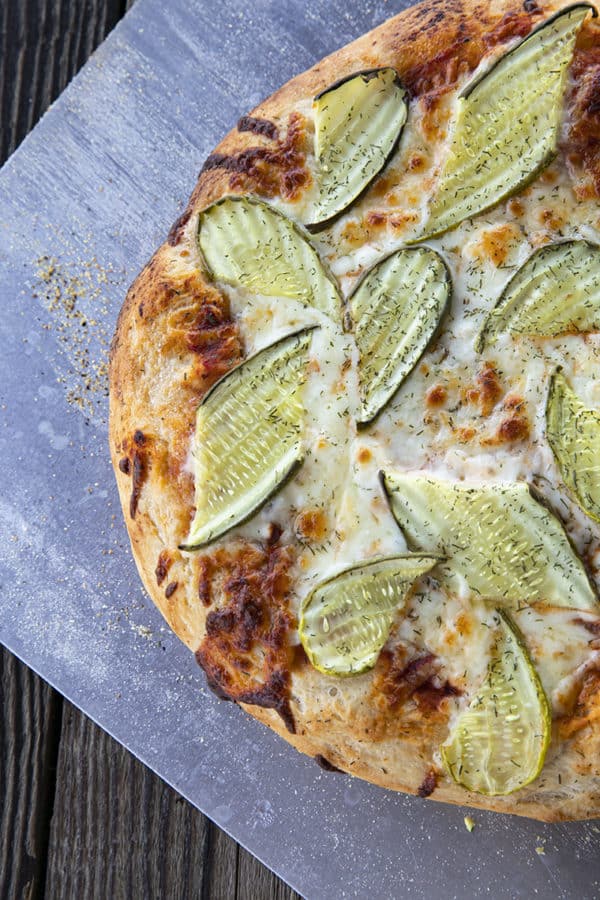
Start out by trying your half sour pickles in this Pickle de Gallo, Dill Pickle Dip, Dill Pickle Egg Salad, or Bagel Burgers with Dill Pickle Cream Cheese.
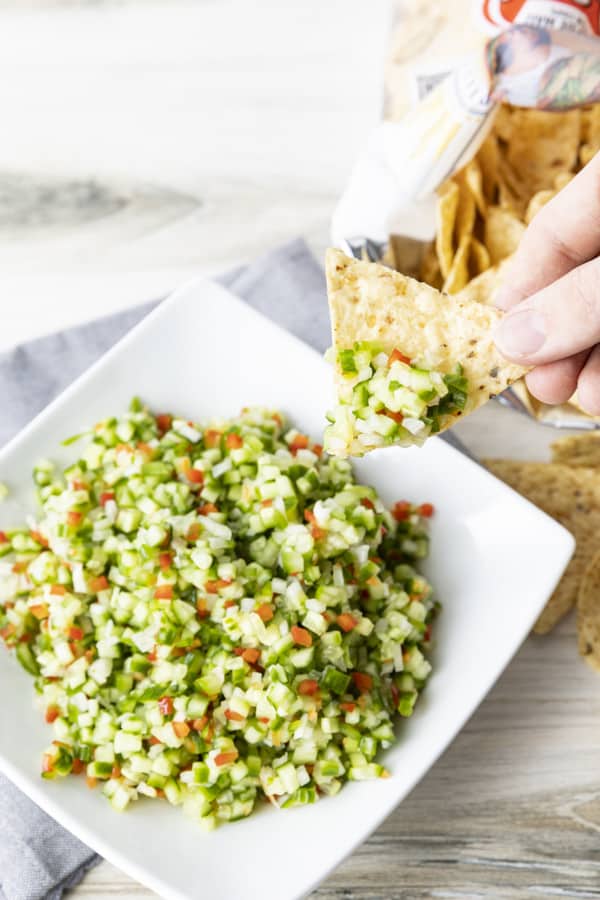
Even better, serve them on our Cheeseburger Salad or Pickle Pizza.
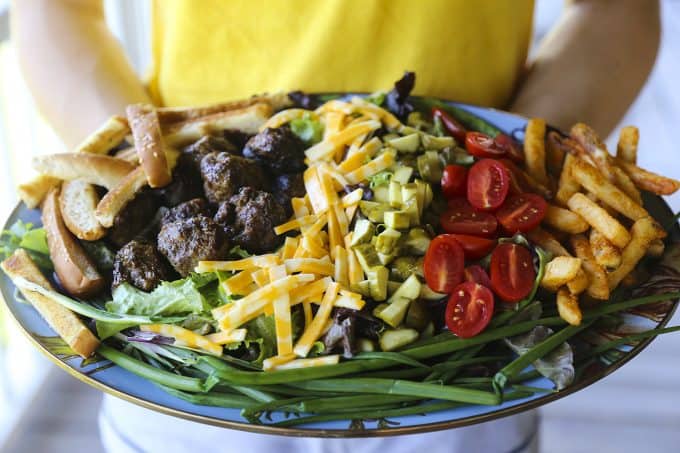
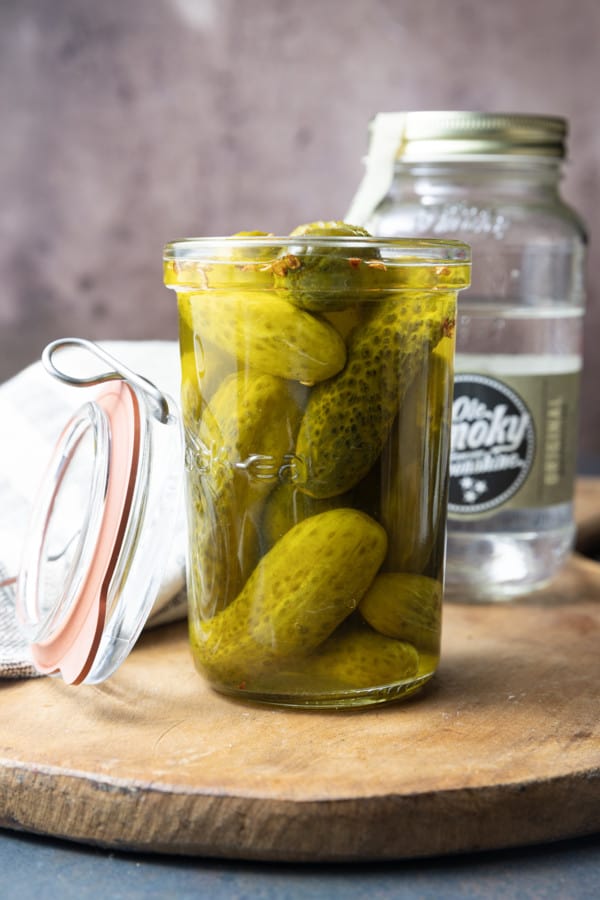
You can even take extra pickles (like that’s a thing!) and make these divine Moonshine Pickles. You’ve never had a better Bloody Mary than one made with homemade Moonshine Pickles!
Half Sour Pickle Recipe
What makes Claussen PIckles different from canned pickles? Claussen pickles, whether homemade or store bought, are a half sour pickle recipe.
That means they’re fermented instead of heat processed. That’s what gives them such great texture.
This half sour pickle recipe yields pickles that are crunchy to the point of making noise when you bite them, cold, and seriously garlicky. Canned, shelf-stable pickles can be chilled, maintain some crunch, and be as garlicky as you want them to be, but they are never, ever going to be the same thing because of science.
When you heat process a jar of pickles you are, in actuality, cooking it and a cooked pickle just plain can’t be as crunchy as an un-cooked half sour pickle recipe.
These homemade pickles keep well in the fridge for about six months, as long as they remain submerged in the brine. In our house, they never last that long because, as the saying goes, “A pickle a day keeps sad times away.”
They say that right? Someone must. If not, I’m going to start. It’s true, after all.
Claussen Pickles
Wash cucumbers but do not scrub them.
Trim 1/8-inch to 1/4-inch from the blossom end of each cucumber and slice in half lengthwise or into quarters, depending on how large your cucumbers are and how big you want them to be when they’re done.
Layer the dill heads or seed, garlic cloves, pickling spices and sliced cucumbers in a gallon jar (or large, wide-mouth, food-safe container). You can evenly divide the dill, garlic cloves, pickling spices, and cucumbers between several smaller jars if needed.
In a separate pitcher or bowl, stir together the remaining ingredients until the salt is dissolved.
Pour the brine over the cucumbers, taking care to make sure all of them are fully submerged. If needed, place a plate or mug or other non-reactive heavy item on the cucumbers to weigh them down and keep them under the brine!
Cover lightly with a lid just perched on top or secure a piece of cheesecloth over the jar with a rubber band to keep fruit flies away. Store any extra brine in a covered jar or pitcher in the refrigerator and use it to top off the brine if it starts to evaporate and expose the pickles to the air.
Leave out of direct sunlight on the counter for at least 24 hours, but up to 4 days, or until the cucumbers taste like pickles throughout.
Fix your lid onto your jar or container and chill thoroughly. These can be stored in the refrigerator for up to six months provided you keep them covered with brine.
NOTE: If at any point in the proceedings “fuzz” or “foam” develops on top of the brine, use a spoon to remove it. If there is “fuzz” attached to any of the cucumbers, remove the ones affected and be sure the others are still fully submerged.
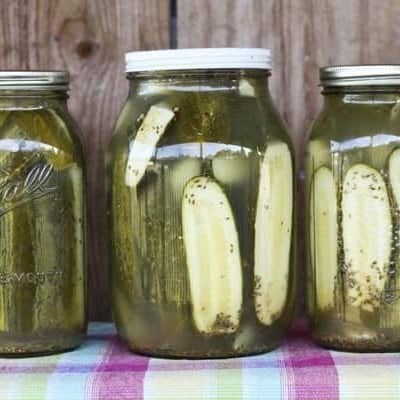
Homemade Claussen Knock-Off Pickles
Equipment
- 1 gallon jar or 4 quart jars or a large, food-safe container with a tight fitting lid
- 1 liquid measuring cup
- 1 large mixing bowl or pitcher
Ingredients
- 35 to 40 small to medium pickling cucumbers
- 1 gallon cold water
- 1 cup apple cider vinegar, preferably raw or white distilled vinegar
- 2/3 cup coarse canning or kosher salt Do NOT fine or use iodized salt!
- 4 cloves garlic or more to taste
- 4 heads fresh dill or 4 tablespoons dried dill seed not weed!
- 2 tablespoons mixed pickling spices
Instructions
- Wash cucumbers but do not scrub them.
- Trim 1/8-inch from the blossom end of each cucumber and slice in half lengthwise or into quarters, depending on how large your cucumbers are and how big you want them to be when they’re done.
- In a gallon jar (or large, wide-mouth, food-safe container) layer the dill heads or seed, garlic cloves, pickling spices and sliced cucumbers.
- In a separate pitcher or bowl, stir together the remaining ingredients until the salt is dissolved.
- Pour the brine over the cucumbers, taking care to make sure all of them are fully submerged. If needed, place a plate or mug or other non-reactive heavy item on the cucumbers to weigh them down and keep them under the brine!
- Cover lightly with a lid just perched on top or secure a piece of cheesecloth over the jar with a rubber band to keep fruit flies away.
- Leave out of direct sunlight on the counter for two to four days*, or until the cucumbers taste like pickles throughout.
- Fix your lid onto your jar or container and chill. These can be stored in the refrigerator for up to six months provided you keep them covered with brine.
- *If at any point in the proceedings “fuzz” or “foam” develops on top of the brine, use a spoon to remove it. If there is “fuzz” attached to any of the cucumbers, remove the ones affected and be sure the others are still fully submerged.
Notes
Nutrition
Nutritional information is an estimate and provided to you as a courtesy. You should calculate the nutritional information with the actual ingredients used in your recipe using your preferred nutrition calculator.
did you make this recipe?
Make sure to tag @foodiewithfam on Instagram and #hashtag it #foodiewithfamily so I can check it out!
Originally published July 22, 2011. Updated with FAQs and Troubleshooting and reposted August 2022.
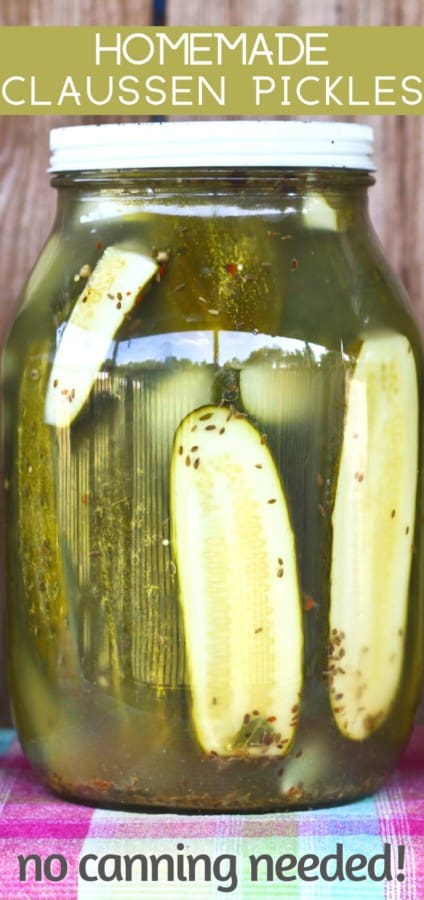
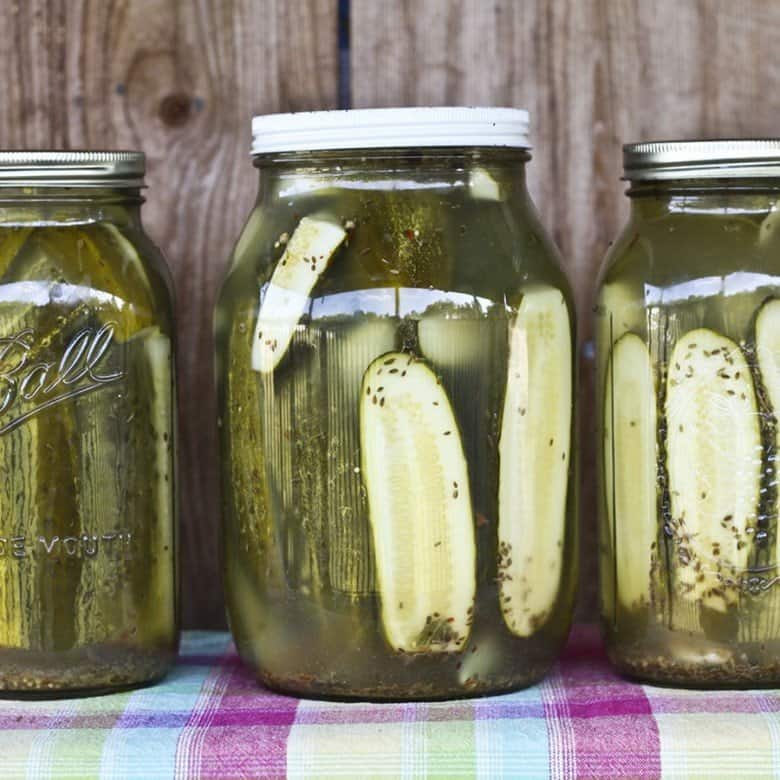
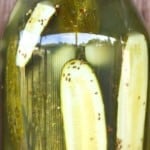



Reader's Thoughts...
Dana Hicks says
OK, so I decided to make a half batch, 2 quarts, one half gallon (2 quarts) of brine. After stuffing the quartered cukes (and the other ingredients) into 2 quart jars, I ended up with a quart of extra brine. So if I were to make a gallon jar’s worth, why would I need to prepare any more than one half gallon of brine? They’ve only been fermenting on the counter for 1 day and they smell terrific already. But I think this is a valid question because if they turn out well, I plan to make a gallon jar full.
Rebecca says
Hi Dana- The extra brine is there because as the liquid evaporates in your pickle jars, you may want to top it off 🙂
Keith says
Thank you very much for the recipe I will be attempting it in a week or so as I’m getting Pickling supplies for my birthday, wish me luck, will let you know how I make out
Donna G says
Hello, first time making pickles but have a ton of cucumbers from my garden. Read all the comments and am still a little confused. Lots of questions. To keep them crunchy, freeze them whole for an hour and then cut them up frozen and put them in brine? Put them all in a large pot but cover loosely and push them down and then put them in jars, cover tightly and put in refrig? Use distilled or bottled water to stop cloudiness.?
Rebecca says
Hi Donna- I can’t speak to the efficacy of any of the methods tried in the comments. As long as you follow instructions in the recipe, you should be a-okay?
Brenda Tallent says
I also love Claussen pickles and usually cannot make it home from the store with a whole jar. I also drink the juice not only because I love it but it also helps with my muscle cramps. I will try this this weekend so thanks.
Stephanie says
If I have to weigh the cucumber down in the brine with a mug, how to I lightly cover them with cheesecloth and a lid? I already have the cucumbers in quart jars. Should I have left them in the bowl?
Rebecca says
Hi Stephanie- it doesn’t actually need to be a mug. It can be a saucer or a stone or anything else. If the cukes stay down of their own accord because you’ve packed them in super tightly, you won’t need a weight at all. 🙂
Nancy Jansson says
I only have regular cucumbers not pickling cucumbers . Can I use those instead?
Rebecca says
Hi there! This recipe is tested using pickling cucumbers. If you try them with regular slicing cucumbers, please let me know what the results are!
Nancy Jansson says
Can I cut this recipe in half or quarters??? I don’t have that many cucumbers.
Rebecca says
You certainly can!
large dave says
I have taken your recipe and replaced the cucumbers with Jalapenos, carrot slices & some onion & cabbage. Looking forward to the next few days!
Rebecca says
That sounds delicious!
Kathleen M Leggio says
Just finished fermenting and put in fridge this morning. Gave my husband one and he LOVED it! We have so many pickle cukes in garden, I’ve been trying different recipes for a couple weeks. Actually tossed 8 quarts in trash cause they were nasty. (Don’t want to mention names, but it was a famous prepackaged dill mix) YOUR recipe is OUTSTANDING!!! My husband said don’t make any other kind of pickle ever! He loves them and I love them. I used white vinegar cause I don’t care for cider vinegar. And I used way more garlic. Oh my, they are fabulous! Easy to make. I just ordered 2 more gallon glass jars on web so I can make more and husband just walked into into livingroom with a bowl of them. He is crazy about them. I did add a grape leaf from our grapevines. Girl, you are the bomb!!! Kudos on a fabulous recipe. Will recommend to everyone!!!
Rebecca says
I’m so, so happy, Kathleen! We love these things, too!
Lynn says
What is in pickling spice I have a huge herb garden that I can probably make my own but not sure what is in it.
Rebecca says
Hi Lynn- Pickling spice is a mixture of dried whole spices. A good staring recipe is:
2 tablespoons mustard seed.
1 tablespoon whole allspice.
2 teaspoons coriander seeds.
2 whole cloves.
1 teaspoon ground ginger.
1 teaspoon crushed red pepper flakes.
1 bay leaf, crumbled.
1 cinnamon stick (2 inches)
Shi says
I made this not too long ago. Three of my jars turned slightly cloudy after a couple of days. Any idea of why?
Rebecca says
It’s just a side effect of the fermentation and shouldn’t hurt your pickles at all!
Robin says
Can you use any cucumbers? I’ve an abundance of “slicing cucumbers will they work ?r
Rebecca says
Hi Robin- I have not tried this with slicing cucumbers. I suspect they might not hold up quite as well, but let me know if you decide to try it!
Linda says
Ready to make these! If I leave them whole and not cut them ( as someone stated to make them more crispy) will they still be infused with all the spices?
Also – does it have to be glass or could it be rubber maid container? You can tell I don’t do pickling! lol
Rebecca says
Hi Linda- I prefer glass for pickling because it doesn’t pick up or impart flavours to the pickles 🙂 You can certainly leave them whole; I often do!
Dan says
I’ve been making refrigerator pickles with equal parts vinegar and water. How in the world do you only use 1 cup of vinegar? I refrigerate mine while they marinate-is that the difference? I want to try these!
Rebecca says
Hi Dan- This is a pickle that’s meant to ferment a little bit. I’d love to hear what you think of these compared to your usual ones if you make them!
Lacey Goldman says
Hello, I’m having trouble getting my dill seeds from floating to the top. Will they develop mold and ruin the batch?
Thank you for your time,
Lacey
Rebecca says
Hi Lacey- They’ll be fine! NO worries!
Lacey Goldman says
Hello, I’m very excited about they pickles! However, my seed are floating to the top. Is that a problem since everything is suppose to be under liquid? I also used ground coriander instead of seed. I looked all over our small town and couldn’t find any. Will that ruin everything?
Thank you for your time,
Lacey
Rebecca says
Hi there… No worries about the seeds floating. I’m a little more concerned about the ground coriander as it is much more potent in the same measurement than the seeds would be. We’ll have to wait and see how it turns out! Please let me know how the flavour is with the ground coriander.
Lacey says
The pickles turned out GREAT with ground coriander! I made seven pints with a teaspoon of coriander in each. My mama and little girl left me ONE jar! ?
Teresa says
These turned out fantastic! Thank you.
Rebecca says
Hooray- Teresa! I’m so happy!!
Geo says
Can these be made without vinegar?
Rebecca says
Hi Geo- I have not tested this recipe without vinegar so I’m not sure. I would not be inclined to do that.
Carol McCarthy says
I made these yesterday, however, science will not allow you to put 1 gallon of cold water along with 35 pickles and 2/3 cup vinegar and salt/spices in a gallon jar…just won’t fit….lol….bought a 2 gallon brewing tub, and now waiting for results, did add some Bay leaves as another pickler said that they keep the pickles crisp…we shall see…will update on Monday. I’m so hoping this recipe turns out great for me since I have a local farm stand that has great looking pickling cukes! Thanks!
Rebecca says
Oh, Carol. 🙂 I know you can’t fit it in there. It defies physics. What it DOES allow you to do, though, is have extra brine on hand for topping off the jar when there is inevitable evaporation. I’ve not tried the bay leaves, but I’ve used fresh grape leaves and they do a great job of keeping things crisp.
Toroso Restaurant says
I love this recipe, I made it easily thanks to your detailed instructions